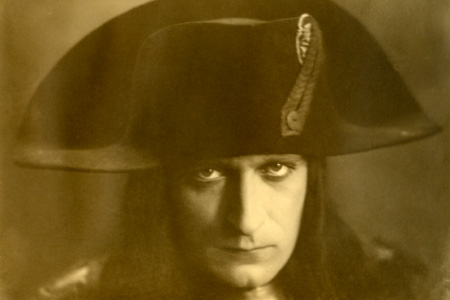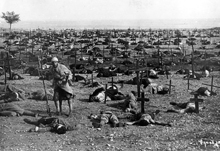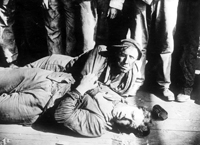For many cinephiles the film event of 2012 was also that of 1981 (and presumably 1926): Abel Gance’s silent epic Napoleon, which toured the U.S. with a symphony orchestra and restored print 31 years ago.
The new incarnation is, if anything, even more of a not-to-be-missed occasion as it includes additional restored footage (upping the runtime to a hefty 5 and 1/2 hours, plus intermissions and dinner break), features a brand-new live score composed and conducted by the estimable Carl Davis (Carmine Coppola’s ’81 accompaniment was not universally loved); is being shown in a painstakingly tinted version closer to its original presentation; and is only happening for four performances, March 24-April 1 at Oakland’s majestic Paramount Theatre via the San Francisco Silent Film Festival. (Forbidding costs and logistics make it unlikely there will be any attempt to bring this package to other U.S. cities, or to record the new score for potential DVD release.)
However if you miss it—or by the time of reading this have missed it—all is not lost. While the kinetic splendor of Gance’s most famous technical innovation, “Polyvision” (a super-widescreen effect achieved by projecting three side-to-side images in precise synch) is Napoleon’s alone, two earlier epics by the filmmaker are otherwise its equal in wild artistic/thematic aspirations and massive physical scale. Both J’accuse and La roue are now available on Fandor.
Before Napoleon’s revival over 30 years ago, arguably Gance’s best-known title outside France was J’accuse. Released just months after the end of World War I, it was a daring statement and a major leap from the already increasingly ambitious pictures he’d made before his own French Army service. It’s the big daddy of all anti-war movies—pacifist messages were actually fairly popular with audiences between the world wars, with All Quiet on the Western Front another famous example.
Like many of his films, the 1919 J’accuse is at core a rather simple story, albeit one blown to grandiose proportions by the writer-director-producer’s desire to write every idea extra large. Here that narrative kernel is a love triangle set in a southern French village, with virtuous Edith (Maryse Dauvray) torn between her often violently jealous husband Francois (Séverin-Mars) and gentleman-poet Jean (Romuald Joube). This rivalry does not abate with the arrival of war, though it also brings the two men (forced to serve in the same regiment) closer together in shared valor.
‘J’accuse’ makes an inspired jump into the realm of the fantastical that smacks across its message with extraordinary force. The war finally over, survivors straggling home and life beginning to resume ‘as usual,’ the armies of the dead arise en masse—marching back to judge whether those they died fighting for deserved the sacrifice. Lightweight minds have dubbed Gance’s classic ‘the first zombie movie,’ but this indelible setpiece is scarcely an exercise in genre horror.
That saga is impressive enough, but for its climax J’accuse makes an inspired jump into the realm of the fantastical that smacks across its message with extraordinary force. The war finally over, survivors straggling home and life beginning to resume “as usual,” the armies of the dead arise en masse—marching back to judge whether those they died fighting for deserved the sacrifice. Lightweight minds have dubbed Gance’s classic “the first zombie movie,” but this indelible setpiece is scarcely an exercise in genre horror. Rather, the horror it means to provoke is that of the public conscience. Its impact was such that on the brink of the next global conflict, Gance remade J’accuse whole as a “talkie”—one arriving too late, in 1938, to slow humanity’s déjà vu march toward an even more devastating global self-immolation.
Gance toured the world with his bold statement, in America meeting D.W. Griffith—his closest equivalent among contemporaries working in the still-new medium—and declining Hollywood overtures. It wasn’t until 1923 that he completed his next film, and no wonder. According to some sources La roue’s original cut ran nearly nine hours, though it was distributed only in much shorter versions. Shorter, we said, not short: The restored edition here is 262 minutes long.
It packs that expanse with more incident than many a 70-minute feature of the same era, however. Again, the narrative germ is a messy romantic conflict. Rescued from a catastrophic train crash at the outset, fetching Norma (Ivy Close) is raised as a daughter to widowed engineer Sisif (Séverin-Mars again) and brother Elie (Gabriel de Gravone). Despite their grinding poverty, they love one another—to the brink of breaking the incest taboos, even if the unknowing lass isn’t actually related to her menfolk. Eventually to make everyone’s lot better, this “Rose of the Rails” caves to the proposals of rich suitor Hersan (Pierre Magnier), who has exploited the family’s penury all along.
La roue’s first part follows this drama of enflamed but thwarted passions with the cruel mechanical force of the locomotive as its primary image and metaphor. Tipping hat to the author he most identified with (as Griffith might have with Dickens), Gance opens the film with Victor Hugo’s homily, “Creation is a great wheel which cannot move without crushing someone.” This section begins and ends with separate train wrecks, but those are only the most outwardly spectacular of many disasters to befall the protagonists here. Even when the second part moves everyone up to the presumably cleaner air of remote, frigid Mount Blanc, their sorrows only accrue further. Alcoholism, attempted suicide, blindness, quite literal cliff-hanging and actual cross-bearing are but a few of the torments suffered. Yet there is a flowering of hope as the epic tale finally closes on yet another “wheel” image, this one at last offering renewal and joy.
Taking further the editorial invention already present in J’accuse, La roue achieves several delirious emotional peaks in stretches of frenzied montage. As monumental as the sheer physical scale of his films often was (the original J’accuse opens strikingly with hundreds of extras spelling out the title with their bodies), Gance was always interested in pushing the boundaries of the medium, creating even more engulfing forms of spectacle via technology. No matter how indulgent their length, his silent films are seldom at rest, camera and cutting heightening our response beyond whatever acting and tableaux alone can contrive. The latter elements may now frequently seem antiquated, Victorian (an era that was hardly a distant memory at the time), but Gance’s modernist technique has lost little of its luster.
After the elephantine Napoleon, he entered the sound era with a project planned over nearly two decades. 1931’s Le Fin du monde was an end-of-world disaster flick with the sermonizing fever of J’accuse, and the filmmaker himself as, perhaps, the Second Coming of Christ. (One can safely assume that Gance possessed a healthy ego.) This prophet declares a comet is coming to wipe that smirk off corrupt mankind’s face, and indeed that event comes to pass.
Despite showy sequences of decadence and destruction, however, the sci-fi morality play was poorly received, recut by its producer without the director’s input. It was a costly failure that had the result of severely curtailing his artistic ambition and freedom thereafter. Nonetheless, he continued working for another four decades, and lived long enough to see his Napoleon again conquer the world—or at least its cineaste population.






